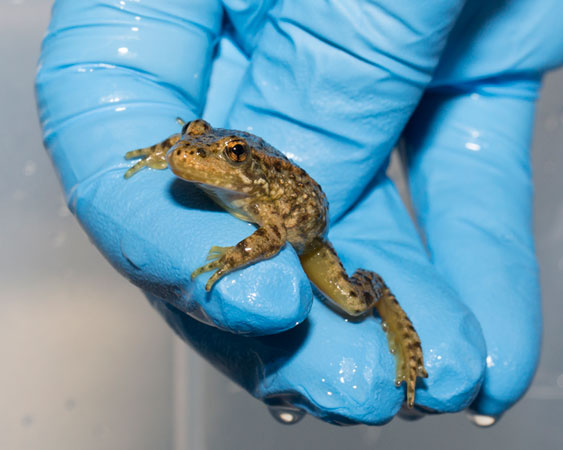|
You are viewing ARCHIVED content published online before January 20, 2025.
Please note that this content is NOT UPDATED, and links may not work. For current information,
visit https://www.nps.gov/aboutus/news/index.htm.

Marianne Hale/San Francisco Zoo
Contact: Colleen Bathe, Chief of Interpretation, Education, and Partnerships, (559) 565-3130 Sacramento Fish and Wildlife Office Sequoia and Kings Canyon National Parks San Francisco Zoo Oakland Zoo Media Advisory: Oakland, CA – December 16, 2015…Critically endangered tadpoles emergency evacuated from the high Sierra and transported to Oakland Zoo and San Francisco Zoo have successfully morphed into healthy mountain yellow-legged frogs. The precious cargo, carefully collected by National Park Service biologists in August, was airlifted from remote locations in Sequoia and Kings Canyon National Parks. “Mountain yellow-legged frogs are getting hammered by non-native trout and disease, and urgent intervention was needed to keep two populations in Sequoia and Kings Canyon National Parks from disappearing,” said Danny Boiano, Aquatic Ecologist at Sequoia and Kings Canyon National Parks. “The National Park Service is fortunate to partner with Oakland and San Francisco zoos on this project; along with several agencies and universities, we are all striving to recover these iconic endangered species.” Zoo biologists met the helicopter in Three Rivers, California and made a four hour drive with 270 tadpoles to the Bay Area, where the rare animals are now housed in quarantine areas at both zoos. “Oakland Zoo and San Francisco Zoo are committed to helping save these frogs, a California heritage species, a local animal that lives just a few hours away in the Sierra Nevada,” said Victor Alm, Zoological Manager at Oakland Zoo. Within recent weeks, the tadpoles morphed into frogs and were specially treated for a deadly fungal disease called chytridiomycosis (chytrid). The highly infectious chtryid has caused more than 200 species of frogs and salamanders to become extinct within the last fifteen years. “Every continent that has amphibians has the disease. It has spread around the world very quickly,” said Dr. Knapp, a research biologist with the Sierra Nevada Aquatic Research Lab at UC Santa Barbara. The rapid and severe decline of the Northern Distinct Population Segment of mountain yellow-legged frogs led the US Fish and Wildlife Service to list them for protection under the Endangered Species Act in 2014. “If this emergency salvage hadn’t occurred, considerably more than 90% of these individuals might not have survived, and we’d [potentially] lose both of these critical populations,” said Dr. Steven Detwiler, Senior Scientist, with the Service’s Sacramento Office, which has helped coordinate the effort to save them. Due to the chytrid crisis, zoos are teaming up with wildlife agencies to help save frog species in peril. Zoo keepers are treating the amphibians with a special type of bath which helps their bodies resist the deadly disease. “We have developed, in collaboration with UC Santa Barbara and researchers working on this project, an experiment to try and immunize these frogs,” said Jessie Bushell, Director of Conservation at San Francisco Zoo. “The zoos re-infect the frogs short-term with chytrid, let them build up a minor infection, monitor them, and then treat them aggressively. Over a course of several months of this treatment, the frogs appear to develop a resistance to chytrid. And that is key to making sure the populations we’re putting back out in the wild have a chance at survival.” In addition to the baths, San Francisco and Oakland zoos are “head-starting” the tiny frogs, raising them into healthy juveniles, better equipped to survive predators and chytrid when they are released back into the wild. “Head-starting allows us to introduce many more adult frogs that are disease-resistant, said Boiano. “Instead of 200 frogs in twenty years, we may give those populations 200 frogs in one year.” The conservation collaboration between the National Park Service, the US Fish and Wildlife Service, Bay Area Zoos, and volunteers is helping to save a native California species and give it legs to thrive and repopulate in the wild. Seeing flourishing frogs in healthy habitats is the ultimate goal of the rescue for recovery, so future generations are able to see and experience these animals first-hand, rather than reading about their demise in text books. If program efforts continue as planned, the goal is to release the yellow-legged frogs in Sequoia and Kings Canyon National Parks in summer of 2016. ABOUT YELLOW LEGGED FROGS: ABOUT THE U.S. FISH & WILDLIFE SERVICE: ABOUT THE NATIONAL PARK SERVICE: ABOUT SAN FRANCISCO ZOO: ABOUT OAKLAND ZOO: For more information visit Sacramento Fish & Wildlife Office: Rescue for Recovery –NPS– |
Last updated: December 16, 2015
